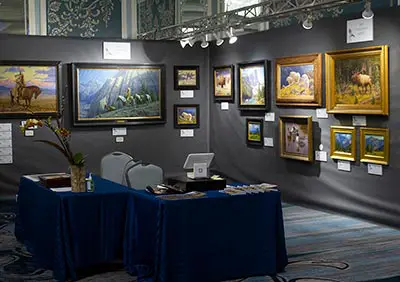
Preparing For a Fine Art Exhibition-Part 2
Properly preparing for a fine art exhibition and properly hanging your work can make all the difference in the success of your show. This is the second part of a multi-part series on how to have a successful art show. See the first post Preparing for an Art Exhibition-Part 1.
Prepare for Your Exhibition by Bringing Your Best Work
Some artists will bring rushed or poor work to a show just to get something on the wall. While sometimes this works, (and ironically, I’ve seen many bad paintings sell), it can be damaging to your career in the long run. If you want to be known as a good artist, bring your best work, it’s as simple as that. You are building a brand, and people will remember. My motto is if I can’t live with it on my wall, then it shouldn’t be on someone else’s wall.
Create a Total Visual Experience
There are several facets to this subject, but sadly many are overlooked, even by professional artists. The first is don’t hang too much work. I see this all the time, at shows and galleries, too many paintings crammed up on the wall with the frames practically touching each other. There are two problems with this approach.
The first goes back to the age-old concept of supply and demand. If you have 40 paintings hanging at a show, then there is no urgency to buy. Many of the paintings I have sold at shows were to people who were afraid they would miss out if they didn’t buy right away. If they walk away to “look around to think about it,” the chances of them coming back is very slim. If there are not many paintings available, they are less likely to take the risk of missing out.
The second problem with too much work is that it just looks sloppy. You are selling something that people will use to beautify their homes, and I have yet to see a home where paintings were cluttered onto a wall like they are in some artist’s booths. This clutter makes it difficult for the would-be collector to visualize the painting in their home, and for some, it will just plain turn them off. You put hard work into making your painting beautiful, compliment that by making your booth a clean, neat visual experience.
But I Need to Hang It All
Often, I will hear artists say that they feel the need to hang everything because having more variety increases your chances for a sale. I will admit there is some truth to that and sometimes that one painting you were not going to hang becomes the one painting that will sell. And I’ve seen artists use the clutter method and still have a good show. This is usually because their work is lower-priced, and/or attendance and buying at the show is really up that year. But in the long run, this can backfire if you want to raise your prices and increase the value perception of your work. I say perception because, at the end of the day, it’s all about perception. The greatest painting ever done (if there is such a thing) will be ignored and completely devalued by most people if it’s in a cheap frame and hanging in a fast-food restaurant. Keep it clean and let the wall breathe.
At Your Fine Art Exhibition Hang the Best First
Finally, in our discussion about preparing for a fine art exhibition, it should be noted that if you bring more paintings than you should hang, put out your best work first. Don’t save the best for last. I’ve seen this time and time again, getting red dots early on in the show can have a snowball effect that can lead to even more sales. If someone walks into your booth and it’s bleeding red dots and the walls are getting empty, they are much more likely to act right away if they like a painting.
When hanging your work, let your wall breathe as stated above, and hang the top row so that the tops of all the frames line up horizontally. This will help give an organized appearance; the rows underneath don’t have to line up perfectly if the top row is lined up. Also, try to hang your work as close to eye level as possible. I always try to make sure my work is not too high, or too low on the wall. You want to think about how someone would hang these paintings in their home and match that in your presentation. And at eye level, they are more likely to notice your work.
There are other things that can help in preparing for a fine art exhibition. Click here to see the first article on this subject. Stay tuned for the next article on how to deal with the challenges of actually selling your work during the show. To see my artwork, visit www.JasonTako.com and visit my YouTube channel.
Jason Tako is a nationally known fine artist who specializes in western, wildlife, plein air, and Historical Native American subject matter. He spent his learning years sketching the wetlands and wooded areas of rural Minnesota. He has been featured in Plein Air Magazine and Western Art Collector Magazine and he was the Featured Artist for the 2020 Southeastern Wildlife Expo. See his work at www.JasonTako.com and his demonstrations on his YouTube Channel.
Warning: Undefined array key "preview" in /home3/mysketc2/public_html/wp-content/plugins/oxygen/component-framework/components/classes/comment-form.class.php on line 75

Warning: Undefined array key "preview" in /home3/mysketc2/public_html/wp-content/plugins/oxygen/component-framework/components/classes/comment-form.class.php on line 79